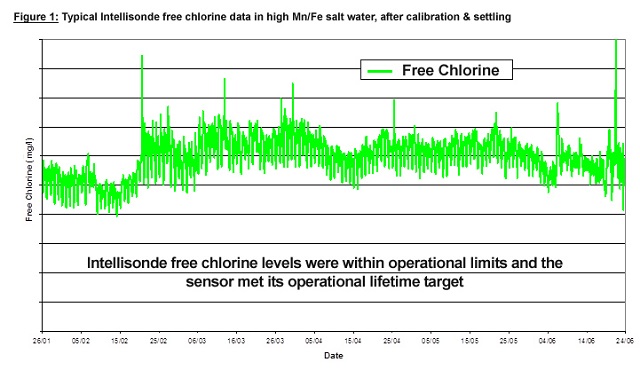Intellitect Water launched the new V2 Intellisonde (IV2) in-pipe water quality monitor in 2012, which offered two new advantages; retained calibration data and improved chlorine measurement. Since that time, IV2 sondes have been successfully installed around the world offering users easier access to water quality data.
However, now that the IV2 sondes have been in operation for nearly a year, one of the key benefits of the latest sensor technology has proven to be its ability to operate very well in a variety of conditions, including water containing high levels of manganese and iron salts.
The chlorine monitoring problems associated with manganese and iron have been well known for many years, so the Intellitect development team gave this a high priority, and Intellisondes now feature a unique electrochemical configuration that effectively eliminates the issues experienced by traditional sensors.
The problems caused by these salts are the result of metal deposition on sensor electrodes, and whilst some of this will re-dissolve, the time taken for equilibrium to be achieved means that these sensors suffer from long settling times and can fail completely. In contrast, the Intellisonde chlorine sensor efficiently reaches equilibrium and operates over an extended lifetime compared with other equipment.

Figure 1 shows Intellisonde measurements of free chlorine in potable water with very high iron/manganese concentrations, demonstrating its effectiveness over the lifetime of the chlorine sensor. Commenting on the data, Intellitect’s Jo Cooper says: “Clients with high levels of manganese or iron salts have been delighted with the performance of the Intellisondes in comparison with traditional technologies, and the facility to measure other parameters has proved very popular because it enables easy evaluation of processes such as flushing.”
The head of an Intellisonde is a mere 3.6cm in diameter, but fully populated can provide continuous water quality data for up to 12 parameters. Measurement options include Free Chlorine, Mono-chloramine, Dissolved Oxygen, Conductivity, pH, ORP/Redox, Flow, Pressure, Temperature, Turbidity and Colour. An ISE channel is also available for Fluoride, Nitrate or Ammonium.
No chemicals or membranes are necessary to operate or calibrate the Intellisonde sensors, and they are quickly and easily replaced at the end of their service lives. The reference electrode, chlorine and dissolved oxygen sensors are replaced after 6 months; pH/ORP and ISE after 1 year; and the conductivity sensor is replaced after 2 years.